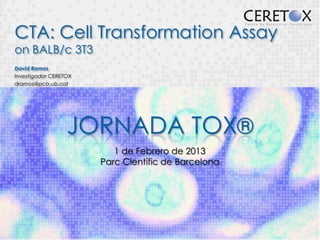
Cell Transformation assay CTA (D. Ramos)
- 1. CTA: Cell Transformation Assay on BALB/c 3T3 David Ramos Investigador CERETOX dramos@pcb.ub.cat JORNADA TOX® 1 de Febrero de 2013 Parc Científic de Barcelona
- 2. Principle of the test Reference OECD DRP 31 In vitro test: Phenotypic alterations (characteristic of tumorigenic cells) in cultured cells induced by carcinogens. These cells induce tumours in susceptible animals (Berwald and Sachs, 1963, 1965) Fast Cost efficient Initial screening for carcinogenic potential 3 types of CTA: Syrian hamster emrbyo cell (SHE pH:6.7) Syrian hamster emrbyo cell (SHE pH:7) BALB/c 3T3
- 3. Materials Experimental system: Clone A31-1-1 derived from BALB/c 3T3 Transformation: associated with malignancy Sensitive to tumour-promoting agents Morphological changes related to neoplasia immortals, autocrine GF, tumorigenecity… Medium: DMEM+10% hiFBS+Ab Solvent Control: Water, DMSO, acetone and ethanol < 5%, 0.2%, 0.5%, 0.1% Positive Control: 1-stage : 5µg/mL MCA 2-stage : 0.2µg/mL MCA as initiator + TPA 0.2 µg/mL as tumour promoter Ref. Kakunaga and Crow (1980) MCA = 3-methylcholanthrene TPA = 12-o-tetradecanoylphorbol-13-acetate
- 4. Experimental design: cytotoxicty test Cells seeded at 100 cells/60-mm dish, 3 dishes per treatment, 24 h Wide range: 5 concentrations Exposure: 72 h + 7 day fresh medium Fixed and stained with 20% Giemsa’s solution Solvent control Determined by colony-forming efficiency (CFE) respect control Colonies Concentration Replica 1 Replica 2 Replica 3 Replica 4 CFE (%) Effect NP 197 200 0 0 0 0 0,00 100,00 NP 197 66,66 3 5 6 14 5,69 94,31 NP 197 22,22 15 18 19 52 21,14 78,86 NP 197 7,4 27 37 33 97 39,43 60,57 NP 197 2,469 60 69 70 199 80,89 19,11 Solvent control 5% H2O 74 92 80 246 100,00 0,00 Positive Control 3% DMSO 30 35 41 106 43,09 56,91 Positive Control, DMSO 3%
- 5. Experimental design: transformation assay Cells seeded at 104cells/60-mm dish, 5 concentrations: 10 dishes/treatment, 4 mL culture medium, 24 h High: 80-90% decrease in CFE 1-stage CTA 2-stage CTA 3 intermediate doses Non-genotoxic Genotoxic substance Low: NO effect in CFE 72 h susbtance 72h as MCA 72h as inductor inductor Non toxic substances: Medium x2 / week refilled with fresh normal medium for 3 days medium for 3 days Refilled with fresh Refill Soluble: ≤ 5 mg/mL during 3½ weeks Insoluble: ≤ 2-times Medium x1 / week TPA as promotor Substance as x2/week promotor x2 / week visible solubility during 2 weeks during 2 weeks during 2 weeks Medium x2 / weekmedium 1 week Mediumx2/ week during x2/ week during week during week once a week once a week during the following week Medium1x / 2 during 2 following during the weeks 2 weeks weeks Fixed and stained with 20% aqueous Giemsa for scoring focus formation
- 6. Results The average number of foci Type III per dish in a treatment group (Foci type III: Spindle-shaped markedly basophilic cells. Piling-up and criss-crossing, clear and marked). Statistical analysis of treatments relative to the solvent control 2-stage CTA MCA as inductor+TPA as promotor Foci Type III 60 Treatment Concentration(µg/ml) FD/TD* Foci III/dish Foci Type III 50 Foci III/dish Solvent Control 10,00% 9/10 3,30 40 Foci Type III 30 Substance 78,125 9/10 3,10 20 Substance 156,25 10/10 4,40 10 0 Substance 312,5 9/10 4,90 10,00% 78,125 156,25 312,5 625 1250 0.2 Substance 625 9/9 5,11 Solvent Substance Substance Substance Substance Substance Control MCA Control Substance 1250 9/10 3,50 Concentration(µg/ml) Control MCA 0.2 10/10 52,00 FD/TD: Number of dishes with foci/total number of dishes examined
- 7. CERETOX Parc Científic de Barcelona - Edifici Cluster c/Baldiri Reixac, 10-12 08028 Barcelona T. 93 403 71 83 www.pcb.ub.cat/ceretox ceretox@pcb.ub.cat http://goo.gl/BGLwt http://goo.gl/VBsu7
